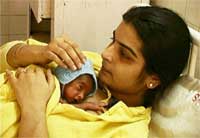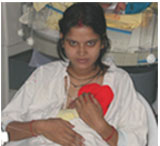Some Cases Of Pediatrics
1.In a 2 months old infant undergoing surgery for biliary atresia, you would avoid one of the following anaesthetic:
A. Thiopentone
B. Halothane
C. Propofol
D. Sevoflurane
2.Regarding neonatal circumcision, which one of the following is true:
A. It should be done without anaesthesia as it is
hazardous to give anaesthesia
B. It should be done without anaesthesia as neonate
do not perceive pain as adult
C. It should be done under local anaesthesia only
D. General anaesthesia should be given to neonate for
circumcision as they also feel pain as adult
3. The ideal muscle relaxant used for a neonate undergoing porto-enterostomy for biliary atresia is:
A. Atracurium
B. Vecuronium
C. Pancuronium
D. Rocuronium
4. The narrowest part of larynx in infants is at the cricoid level. In administering anesthesia this may lead to all except:
A. Choosing a smaller size endotracheal tube
B. Trauma to the subglottic region
C. Postoperative stridor
D. Laryngeal oedema
Answers:
1-B (Halothane)
Discussion
Halothane has hepatotoxic potential which is increased in presence of decrease blood flow to liver and preoperative liver disease.
Explanation
A. Thiopentone: IV inducing agent,ultra short acting, 2.5% solution used leads to CNS depression lasting more than 12 hours. It is used for short operation that are not painful.
B. Halothane: Inhalational anesthetic,contraindicated in the presence of jaundice. It is a potent GA, poor analgesic or muscle relaxant. It leads to direct myocardial depression and respiratory depression. It causes severe hepatic necrosis (idiosyncratic). It is preferred in asthma as it is a bronchodilator.
C. Propofol: Action is for 15 minutes only,used in day-case surgery,dose dependent respiratory depression occurs.
D. Sevoflurane: Good for pediatric patients,pleasant even through face mask,recovery is smooth. It should not be used in closed circuit with sodalime as it is then degraded.
2-D (General anaesthesia should be given to neonate for circumcision as they also feel pain as adult)
Explanation
Neonates also have developed sensory system.
3- A (Atracurium)
Discussion
Atracurium: 4 times less potent than pancuronium and shorter acting too,can be used in liver and kidney disease also as it is eliminated spontaneously in plasma by non enzymatic degradation [by hoffman degradation]. Hemo-dy-namically it is neutral.so liver plays no role in it metabolism.
Explanation
The metabolism of atracurium is mainly by Hoffman degradation which is non-enzymatic, pH and temperature dependent.
The metabolism of vecuronium, pancuronium and rocuronium are dependent on liver and in biliary atresia liver functions are deranged.
4-A (Choosing a smaller size endotracheal tube)
Discussion
• Endotracheal tubes that pass through the glottis may still implinge upon the cricoid cartilage, causing postoperative edema, stridor, croup and airway obstruction
To pervent these complications, smaller size tube is selected.
Friday, September 5, 2008
Pediatrics: Systems Review for History Taking
Pediatrics: Systems Review for History Taking
Cardiovascular
Chest pain, pressure
Shortness of breath, exertion required
Lie flat or use pillows, how many pillows
Awoke breathless at night
Noticed heart racing, aware of heartbeat
Ankle swelling
Cold/ blue hands, feet
Pulmonary
Sore throats, earaches
Cough: sputum, blood
Shortness of breath, wheeze
Snore loudly, apnea
Fever, night sweats
Recent chest X-ray
Alimentary
Weight, appetite changes
Abdominal pain or discomfort
Bloating, distention
Indigestion
Nausea, vomiting: *******s
Bowel habits: change, number
Incontinence, constipation/ diarrhea
Stool: colour, blood/ black, consistency, mucous
Nervous
Headaches
Dizziness, vertigo
Faints, seizures, blackouts
Weakness, numbness
Sleep disturbances
Limp, ataxia, tremors
Concentration, memory
Genitourinary
Enursesis
Changes to urine quantity, colour
Blood in urine
Genital rashes, lumps
Pain, bleeding in periods
Endocrine
Prefer hot or cold weather
Sweating
Fatigue
Hand trembling
Neck swelling
Skin, hair, voice changes
Thirst
Integumental
Itchy
Rashes
Bruising
Swelling
Colour changes
Hematological
Bruise easily, difficulty stopping bleeds
Lumps under arms, neck, loin
Clots in legs, lungs
Fevers, shakes, shivers
Rheumatoid
Joints: pain, stiffness, swollen
Variation in joint pain during day
Fingers painful/ blue in cold
Dry mouth, red eyes
Skin rash
Back, neck pain
Anything else you think I should add?
Cardiovascular
Chest pain, pressure
Shortness of breath, exertion required
Lie flat or use pillows, how many pillows
Awoke breathless at night
Noticed heart racing, aware of heartbeat
Ankle swelling
Cold/ blue hands, feet
Pulmonary
Sore throats, earaches
Cough: sputum, blood
Shortness of breath, wheeze
Snore loudly, apnea
Fever, night sweats
Recent chest X-ray
Alimentary
Weight, appetite changes
Abdominal pain or discomfort
Bloating, distention
Indigestion
Nausea, vomiting: *******s
Bowel habits: change, number
Incontinence, constipation/ diarrhea
Stool: colour, blood/ black, consistency, mucous
Nervous
Headaches
Dizziness, vertigo
Faints, seizures, blackouts
Weakness, numbness
Sleep disturbances
Limp, ataxia, tremors
Concentration, memory
Genitourinary
Enursesis
Changes to urine quantity, colour
Blood in urine
Genital rashes, lumps
Pain, bleeding in periods
Endocrine
Prefer hot or cold weather
Sweating
Fatigue
Hand trembling
Neck swelling
Skin, hair, voice changes
Thirst
Integumental
Itchy
Rashes
Bruising
Swelling
Colour changes
Hematological
Bruise easily, difficulty stopping bleeds
Lumps under arms, neck, loin
Clots in legs, lungs
Fevers, shakes, shivers
Rheumatoid
Joints: pain, stiffness, swollen
Variation in joint pain during day
Fingers painful/ blue in cold
Dry mouth, red eyes
Skin rash
Back, neck pain
Anything else you think I should add?
Latest GROWTH CHARTS
Latest GROWTH CHARTS..!!
Latest Growth Charts are available which include not only height and weight but also Head circumference...
Get from here..
Get from here..
Kangaroo Mother Care
This is Material prepared by AIIMS..
 One third of all neonates born in India are low birth weight (LBW), which is associated with increased risk of morbidity and mortality. Kangaroo Mother Care (KMC) is an inexpensive, simple and effective method of improving outcomes of LBW neonates especially in resource poor settings. However, KMC is new to this country and the expertise is limited to only a few institutions and a handful of nurses and pediatricians. Realizing the urgent need a Net work of five institutions in India was created to catalyse promotion of kangaroo mother care in India through dissemination of information and skills.
One third of all neonates born in India are low birth weight (LBW), which is associated with increased risk of morbidity and mortality. Kangaroo Mother Care (KMC) is an inexpensive, simple and effective method of improving outcomes of LBW neonates especially in resource poor settings. However, KMC is new to this country and the expertise is limited to only a few institutions and a handful of nurses and pediatricians. Realizing the urgent need a Net work of five institutions in India was created to catalyse promotion of kangaroo mother care in India through dissemination of information and skills.
The specific objectives of the KMC Network are to:
Resource material on KMC
http://www.newbornwhocc.org/resources/kmc-poster.pdf
http://www.newbornwhocc.org/resources/kmci_network_manual.pdf
http://www.newbornwhocc.org/resources/kmc_practical_guide.pdf
This is its Video
http://www.newbornwhocc.org/resources/kmc_aiims.wmv
 One third of all neonates born in India are low birth weight (LBW), which is associated with increased risk of morbidity and mortality. Kangaroo Mother Care (KMC) is an inexpensive, simple and effective method of improving outcomes of LBW neonates especially in resource poor settings. However, KMC is new to this country and the expertise is limited to only a few institutions and a handful of nurses and pediatricians. Realizing the urgent need a Net work of five institutions in India was created to catalyse promotion of kangaroo mother care in India through dissemination of information and skills.
One third of all neonates born in India are low birth weight (LBW), which is associated with increased risk of morbidity and mortality. Kangaroo Mother Care (KMC) is an inexpensive, simple and effective method of improving outcomes of LBW neonates especially in resource poor settings. However, KMC is new to this country and the expertise is limited to only a few institutions and a handful of nurses and pediatricians. Realizing the urgent need a Net work of five institutions in India was created to catalyse promotion of kangaroo mother care in India through dissemination of information and skills.The specific objectives of the KMC Network are to:
- Disseminate resource material on KMC (adapted to Indian conditions) among mothers and healthcare providers
- Disseminate counseling and clinical skills in KMC among nurses and physicians by conducting skills-based workshops in the country
- Catalyze operationalization of KMC practice at selected institutions by on-site training of health personnel
- Coordinate in-service training of nurses and physicians at the network of KMC demonstration centres in the country
- Launch an India KMC Website to disseminate information on KMC to mothers and families, health professionals, and other stake-holders.

Resource material on KMC
http://www.newbornwhocc.org/resources/kmc-poster.pdf
http://www.newbornwhocc.org/resources/kmci_network_manual.pdf
http://www.newbornwhocc.org/resources/kmc_practical_guide.pdf
This is its Video
http://www.newbornwhocc.org/resources/kmc_aiims.wmv
National Resuscitation Program Lectures
The American Academy of Pediatrics (AAP) and the American Heart Association (AHA) introduced the National Resuscitation Program (NRP) in the late 1980s to disseminate standard resuscitation guidelines among physicians and nurses. The program consisted of a structured self-reading manual, a hands-on workshop using mannequins and resuscitation equipment, a certification process, and standardization of instructors and the instruction process. Following slides are developed by AIIMS Division based on the latest guidelines 2005 .
http://www.newbornwhocc.org/pdf/teaching-aids/pps/NRP-Introduction.ppt
http://www.newbornwhocc.org/pdf/teaching-aids/pps/Initial%20Steps.ppt
http://www.newbornwhocc.org/pdf/teaching-aids/pps/Bag%20&%20Mask%20equipment.ppt
http://www.newbornwhocc.org/pdf/teaching-aids/pps/Bag%20&%20Mask%20Procedure.ppt
http://www.newbornwhocc.org/pdf/teaching-aids/pps/NRP_2006-Medications.ppt
http://www.newbornwhocc.org/pdf/teaching-aids/pps/Chest%20Compresions.ppt
http://www.newbornwhocc.org/pdf/teaching-aids/pps/NRP-intubation.ppt
http://www.newbornwhocc.org/pdf/teaching-aids/pps/Special_considerations-NRP.ppt
http://www.newbornwhocc.org/pdf/teaching-aids/pps/NRP_Poster.ppt
http://www.newbornwhocc.org/Changes%20NRP%20Journal%20NNF.pdf
http://www.newbornwhocc.org/pdf/teaching-aids/pps/NRP-Introduction.ppt
http://www.newbornwhocc.org/pdf/teaching-aids/pps/Initial%20Steps.ppt
http://www.newbornwhocc.org/pdf/teaching-aids/pps/Bag%20&%20Mask%20equipment.ppt
http://www.newbornwhocc.org/pdf/teaching-aids/pps/Bag%20&%20Mask%20Procedure.ppt
http://www.newbornwhocc.org/pdf/teaching-aids/pps/NRP_2006-Medications.ppt
http://www.newbornwhocc.org/pdf/teaching-aids/pps/Chest%20Compresions.ppt
http://www.newbornwhocc.org/pdf/teaching-aids/pps/NRP-intubation.ppt
http://www.newbornwhocc.org/pdf/teaching-aids/pps/Special_considerations-NRP.ppt
http://www.newbornwhocc.org/pdf/teaching-aids/pps/NRP_Poster.ppt
http://www.newbornwhocc.org/Changes%20NRP%20Journal%20NNF.pdf
All Lectures on Newborn
Here are lectures prepared by NNF Teaching Aids, AIIMS..
Just right click on the link and click " save as "
http://www.newbornwhocc.org/pdf/teaching-aids/pps/dangersigns.pps
http://www.newbornwhocc.org/pdf/teaching-aids/pps/feedingnewborn.pps
http://www.newbornwhocc.org/pdf/teaching-aids/pps/hypothermia.pps
http://www.newbornwhocc.org/pdf/teaching-aids/pps/jaundice.pps
http://www.newbornwhocc.org/pdf/teaching-aids/pps/kmc.pps
http://www.newbornwhocc.org/pdf/teaching-aids/pps/managementoflwb.pps
http://www.newbornwhocc.org/pdf/teaching-aids/pps/neonatalsepsis.pps
http://www.newbornwhocc.org/pdf/teaching-aids/pps/newborn.pps
http://www.newbornwhocc.org/pdf/teaching-aids/pps/normalnewborn.pps
http://www.newbornwhocc.org/pdf/teaching-aids/pps/postasphyxia.pps
http://www.newbornwhocc.org/pdf/teaching-aids/pps/respiratorydistress.pps
Just right click on the link and click " save as "
http://www.newbornwhocc.org/pdf/teaching-aids/pps/dangersigns.pps
http://www.newbornwhocc.org/pdf/teaching-aids/pps/feedingnewborn.pps
http://www.newbornwhocc.org/pdf/teaching-aids/pps/hypothermia.pps
http://www.newbornwhocc.org/pdf/teaching-aids/pps/jaundice.pps
http://www.newbornwhocc.org/pdf/teaching-aids/pps/kmc.pps
http://www.newbornwhocc.org/pdf/teaching-aids/pps/managementoflwb.pps
http://www.newbornwhocc.org/pdf/teaching-aids/pps/neonatalsepsis.pps
http://www.newbornwhocc.org/pdf/teaching-aids/pps/newborn.pps
http://www.newbornwhocc.org/pdf/teaching-aids/pps/normalnewborn.pps
http://www.newbornwhocc.org/pdf/teaching-aids/pps/postasphyxia.pps
http://www.newbornwhocc.org/pdf/teaching-aids/pps/respiratorydistress.pps
Subscribe to:
Posts (Atom)